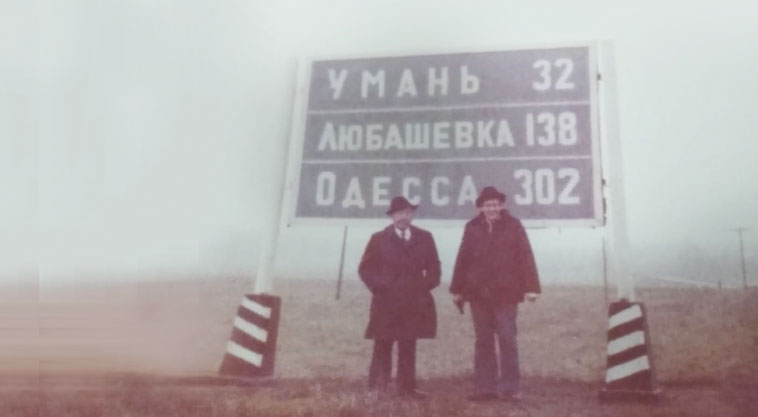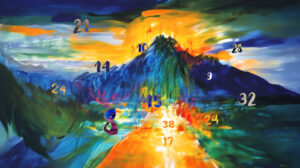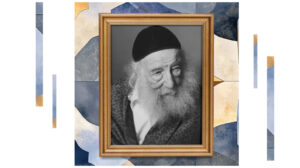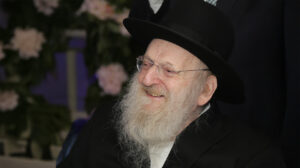Like His Own Children


Rabbi Rosenfeld’s appearance was so ordinary that most people had no idea he was a giant in Torah, halachah, and Kabbalah

Before anyone used the term baal teshuvah, Rabbi Zvi Aryeh Rosenfeld was on the front lines of kiruv, bringing Breslov chassidus to a new world and teaching a young generation of Americans about Jewish basics. Forty years after his untimely passing, he’s still their rebbi
He was one of those rare men who fomented a revolution in Yiddishkeit — and whose impact continues to be felt on successive generations four decades after his passing. Rabbi Zvi Aryeh Rosenfeld was perhaps best-known as the brilliant Breslov mashpia of the last generation, the person primarily responsible for bringing Breslov chassidus to American shores and for opening the locked Soviet door to Rebbe Nachman’s backyard kever in the 1960s.
But Rabbi Rosenfeld was first and foremost a phenomenal educator, one of the first kiruv activists in the US before anyone even knew the term baal teshuvah. He was threatened with violence and was even subjected to humiliating police searches after irate parents filed complaints against him for brainwashing and kidnapping their children, but the boys and girls he instructed flourished under his care. He taught them how to keep Shabbos, how to understand Chumash, how to learn Gemara and prepare for their bar mitzvahs, and even how to find a shidduch. And as for his students — most of whom are now older than he was at his untimely passing at age 56 on 11 Kislev 5739 (1978) — he’s still their rebbi.
This clean-shaven, American-raised chassid was born in Gdynia, Poland, in 1922, after his parents were forced to flee their hometown of Kremenchug, Ukraine. The following year, the Rosenfelds — once wealthy from Reb Yisrael Abba’s lumber business but leveled to poverty from pogroms and the Communist nationalization of assets —arrived penniless to America.
The family settled in Brownsville, Brooklyn, and Zvi Aryeh attended Yeshivas Rabbeinu Chaim Berlin, moved on to Torah Vodaath, and at age 17, transferred to Yeshivas Beis Yosef Novardok in Boro Park, headed by Rav Avraham Jofen, the son-in-law of Rav Yosef Yoizel Horowitz, known as the Alter of Novardok. (Rav Jofen reestablished the venerated yeshivah after arriving in New York as a destitute refugee together with other gedolei Torah who managed to secure exit visas from Russia.)
It didn’t take long before Zvi Aryeh’s phenomenal genius and diligence were recognized, and Rav Jofen assigned his own son, Rav Yaakov, as his chavrusa (Rav Yaakov followed his father as rosh yeshivah of Beis Yosef until his own passing in 2003). At age 23, after completing Shas twice, he was one of only five students to receive semichah directly from Rav Jofen.
A year later, Rabbi Rosenfeld married Rebbetzin Tzipporah (nee Faivelson), a shidduch that had been arranged by Rav Yaakov Jofen’s wife, Rebbetzin Jean. At first glance, it seemed an unlikely match: Reb Zvi Aryeh traced his lineage to Rav Aharon of Breslov, while Tzipporah was the daughter of a well-respected Lithuanian family. The Faivelsons valued Reb Zvi Aryeh’s Torah scholarship, but were taken by surprise at the wedding when Rabbi Rosenfeld came wearing a gartel. People started whispering — how could the granddaughter of Rabbi Shmuel Avigdor Faivelson, a prominent Lithuanian rav, marry a bochur who wears a gartel? Then one of the relatives commented, “Why is everyone so upset? Reb Shmuel Avigdor also wore a gartel!” (It turned out that Rabbi Faivelson wore a gartel once a year, on Simchas Torah.)
Speed Learning Rabbi Rosenfeld decided early on that he would work to earn a living, but he deliberated over which avenue to pursue. Already then, he was known for being meticulous with money matters, a trait he cultivated and perfected all his life. (While over the years he helped raise huge sums for the poor of Eretz Yisrael and other causes, his own family lived in extreme privation.)
“I know one thing,” he told his chavrusa, Rav Yaakov Jofen, “I’ll never go into business. It’s impossible to run a business without ever taking advantage of the customer. Nothing is worth that.”
Despite having already earned his degree in accounting (he completed the six-month program in just three weeks), Rabbi Rosenfeld decided to change course after discussing the matter with the Rosh Yeshivah. Rav Jofen saw in his talmid the potential to be a great educator, and felt that his talents and brilliance would be wasted in accounting. Indeed, he succeeded in completing the entire Shas every few years.
His son-in-law and talmid Rabbi Chaim Kramer, head of the Breslov Research Institute, recalls how he would learn with two fingers, seemingly scanning the page “with one finger on the Gemara text and the other on Rashi. He would drag his fingers down the page as if he were just scrolling,” says Rabbi Kramer. “It was like speed learning, but he absorbed and remembered every word and idea. His amazing speed gave him such a breadth and depth of information that he had an encyclopedic knowledge of Gemara, Shulchan Aruch, and Kabbalah.” (One year when the Rosenfeld family spent Succos in Eretz Yisrael, they celebrated Simchas Torah in Yeshivas Mir, which had a second-day Yom Tov minyan where aliyos were sold in exchange for a specific learning commitment. The auctioning began with three hundred pages of Gemara. Rabbi Rosenfeld, who looked like a regular American balabos, shocked everyone by asking if three hundred pages of Zohar would be acceptable.)
Finally, a Rebbe
Rabbi Rosenfeld’s appearance was so ordinary that most people had no idea he was a giant in Torah, halachah, and Kabbalah.
He began working as a congregational rabbi at the Young Israel of Coney Island and taught at the Shaarei Torah Talmud Torah, headed by Rabbi Yechezkel Kahane (father of the late Rabbi Meir Kahane and ybl”c, Rabbi Nachman Kahane of the Old City). Rabbi Rosenfeld taught after-school classes for elementary-school children to give them a rudimentary education in Yiddishkeit and to prepare boys for their bar mitzvah. But those kids were immersed in American culture and had little interest in wasting their free time on religious studies. Their parents didn’t want their children becoming “too religious” either. Somehow, though, Rabbi Rosenfeld got through to them.
In addition to his teaching, Rabbi Rosenfeld had a sideline task. After his father passed away in 1947, Rabbi Rosenfeld was charged with taking over Reb Yisrael Abba’s extensive tzedakah activities, which included raising money for the tiny Breslover community in Jerusalem. This project involved extensive correspondence with Rav Avraham Sternhartz, one of the elders of the Breslover chassidim in Jerusalem and his father’s rav from Kremenchug.
As the son of a Breslover chassid and a scion of prominent Breslov personalities, Rabbi Rosenfeld had learned the few Breslov seforim that were available at the time in America and endeavored to put what he learned into practice. However, with no more than a handful of Breslov chassidim in all of the US, he had no one to give his chassidic side a direction for life.
Rabbi Rosenfeld found in Rav Sternhartz a brilliant talmid chacham who was able to answer his most complex questions. And so Rav Sternhartz became the Novardok talmid’s rebbi in his further study of Breslov chassidus. It was also through Rav Sternhartz that Reb Zvi Aryeh was inspired to take a major part in financing the building of the central Breslov shul in Meah Shearim. At the time, when there were so few Breslover chassidim, it wasn’t considered prudent to invest in such a huge building, yet within a decade of its construction, Rabbi Rosenfeld’s vision proved prescient, with the massive growth of the Breslov community. (The Israeli Breslovers assumed that Rabbi Rosenfeld was a wealthy American philanthropist, but those who traveled to the United States were shocked to discover that he was living in conditions that were poor even by their standards.)
Rabbi Rosenfeld finally met his chassidus rebbi in person in 1949, when he made his first trip to Eretz Yisrael. In fact, his lifelong dream was to move to the Holy Land, and he was opposed to purchasing property anywhere else. During this visit (it was to be the first of 52!), Rabbi Rosenfeld discussed with Rav Sternhartz his desire to move to Eretz Yisrael, grow a beard, and join the Breslov kehillah. However, when he described his work in the United States, how he had begun teaching youth and bringing them back to Yiddishkeit, Rav Sternhartz told him that he must remain in America. “Although living in Eretz Yisrael is kodesh, bringing American youth back to their heritage is kodesh kodashim,” he said. Rabbi Rosenfeld accepted that this was his mission, and decided that if a year would go by without a new talmid, he would leave the United States. Of course, that never happened, and he remained until 1978, shortly before his passing.
Rabbi Rosenfeld accepted these words as a charge for life, returning to the US with a renewed commitment.
Oops! We could not locate your form.












